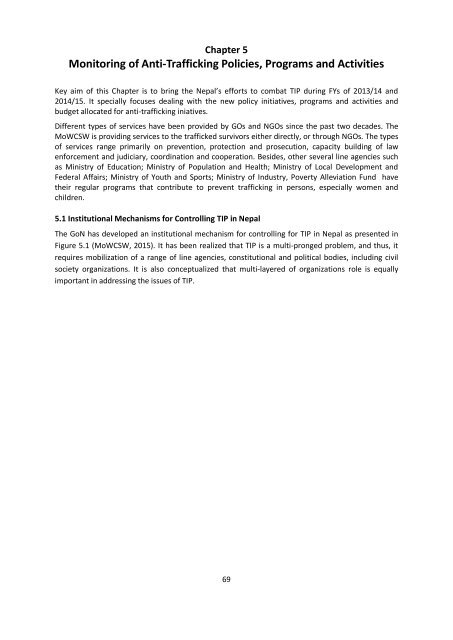TRAFFICKING IN PERSONS
1Spfyta
1Spfyta
Create successful ePaper yourself
Turn your PDF publications into a flip-book with our unique Google optimized e-Paper software.
5.2 Nepal in Trafficking in Persons (TIP) Reports<br />
The United States Government has been publishing Trafficking in Persons Report (TIP) annually since<br />
2001. It places countries around the globe in monitoring of trafficking in four categories: i) Tire 1; ii)<br />
Tire 2; iii) Tire 2 Watch List (WL); and iv) Tire 3. Tire 1 countries are those whose governments fully<br />
comply with the Trafficking Victims Protection Act’s (TVPA) minimum standards; Tire 2 countries<br />
whose governments do not fully comply with the TVPA’s minimum standards, but are making<br />
significant efforts to bring themselves into compliance with those standards; Tire 2 WL countries<br />
whose governments do not fully comply with the TVPA’s minimum standards, but are making<br />
significant efforts to bring themselves into compliance with those standards and Tire 3 countries<br />
whose governments do not fully comply with the minimum standards and are not making significant<br />
efforts to do so.<br />
Nepal has been reminded in Tire 2 over the last 5-years (Box 5.1). Compared to other countries<br />
especially Pakistan, Sri Lanka and Afghanistan, Nepal progress appears to be satisfactory in fighting<br />
against trafficking. Nepal has been remained in Tire 2 mainly because Nepal cannot fully protect its<br />
migrant workers from falling into forced labor situation in Nepal, India, Middle East, Asia, Europe<br />
and USA in different informal sectors of the economy. Forced labor is facilitated by recruiting<br />
agencies. Unregistered migrants, particularly those destined via India are particularly vulnerable to<br />
forced labor. Despite this, according to the TIP Report 2015, the GoN increased efforts to prosecute<br />
suspected trafficking offenders; prepared the implementation plan for its NPA and increased funding<br />
allocations to all 75 districts for establishment of at least three new village-level anti-trafficking<br />
committees. The GoN’s efforts, however, are grossly inadequate in victim identification and<br />
protection and Nepal has yet to a party to the UN Trafficking Protocol 2000.<br />
Box 5.1 Comparing Nepal’s progress in combating trafficking in persons with other SAARC countries<br />
Country 2010 2011 2012 2013 2014 2015<br />
Nepal Tire 2 Tire 2 Tire 2 Tire 2 Tire 2 Tire 2<br />
Bangladesh Tire 2 WL Tire 2 WL Tire 2 Tire 2 Tire 2 Tire 2<br />
India Tire 2 WL Tire 2 Tire 2 Tire 2 Tire 2 Tire 2<br />
Pakistan Tire 2 Tire 2 Tire 2 Tire 2 Tire 2 WL Tire 2 WL<br />
Sri Lanka Tire 2 WL Tire 2 Tire 2 Tire 2 WL Tire 2 WL Tire 2 WL<br />
Afghanistan Tire 2 WL Tire 2 WL Tire WL Tire 2 WL Tire 2 Tire 2<br />
Source: US Department of State, TIP Reports 2010, 2011, 2012, 2013, 2014 and 2015.<br />
5.3 Key Policy Initiatives<br />
• Adopted National Plan of Action (NPA) against Trafficking in Women and Children and their<br />
Sexual Exploitation in 1998. This NPA identified six thematic areas for intervention: i) Policy,<br />
Research, and Institutional Development; ii) Legislation and Enforcement; iii) Awareness<br />
Creation, Advocacy, Networking and Social Mobilization; iv) Health and Education; v) Income<br />
and Employment Generation; and vi) Rescue and Reintegration. In 2001, two priority areas,<br />
namely, Trans-border, Regional and International Issues and Monitoring and Evaluation were<br />
added.<br />
• Adopted NPA against Trafficking in Persons 2011-2021, taking into account the new<br />
trafficking patterns such as those associated with foreign labor migration. The NPA identifies<br />
five broad areas for interventions: prevention, protection, prosecution, capacity building,<br />
and cooperation for reinforcing the prevention and control of trafficking in women and<br />
children, a separate NPA has been implemented since 2012 with intervention areas including<br />
prevention, protection, prosecution, and capacity development of concerned institutions.<br />
• Adopted National Minimum Standards for Victims Care and Protection (NMSVCP) and the<br />
Standard Operating Procedures (SOPs) for Rehab Shelter Homes for trafficking survivors in<br />
2012 for ensuring adequate protection, assistance and provision of safe homes.<br />
71


